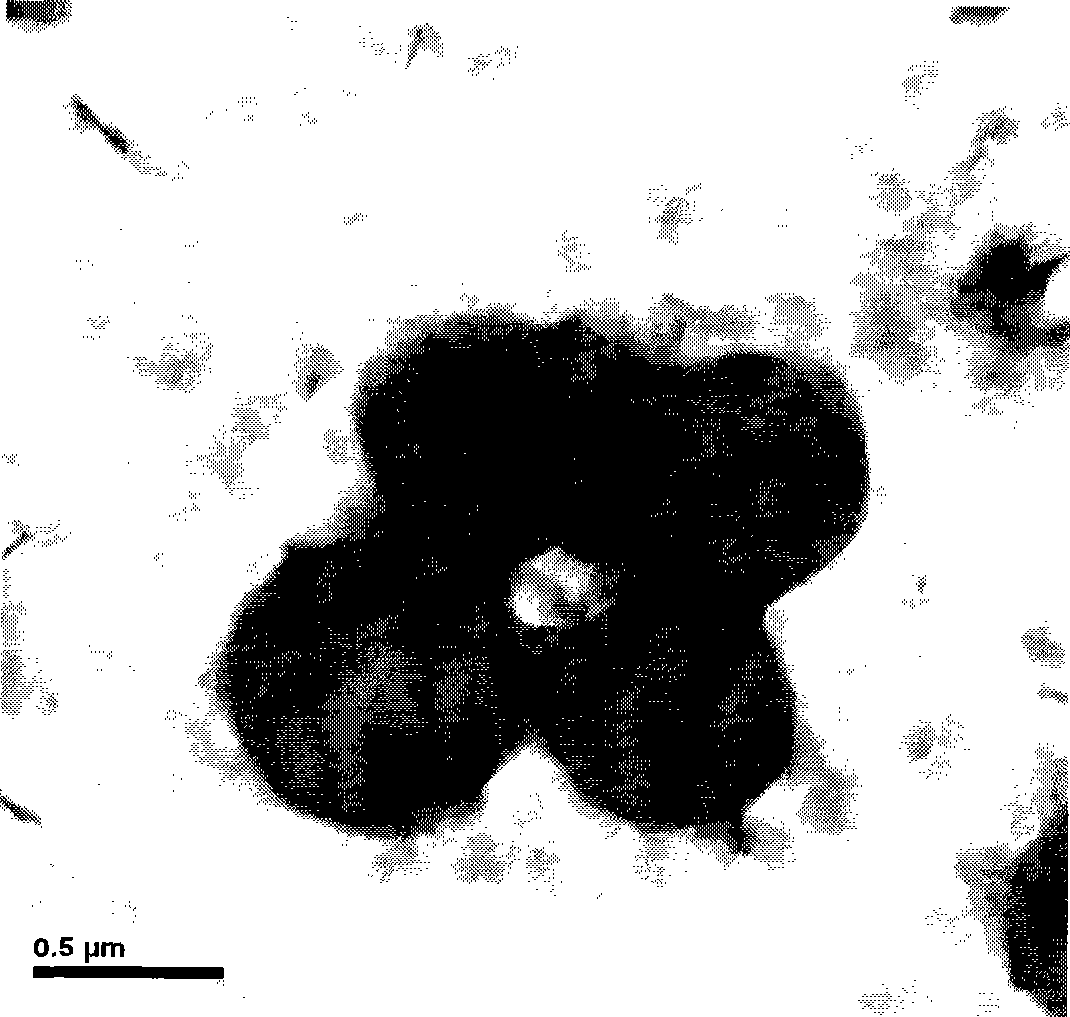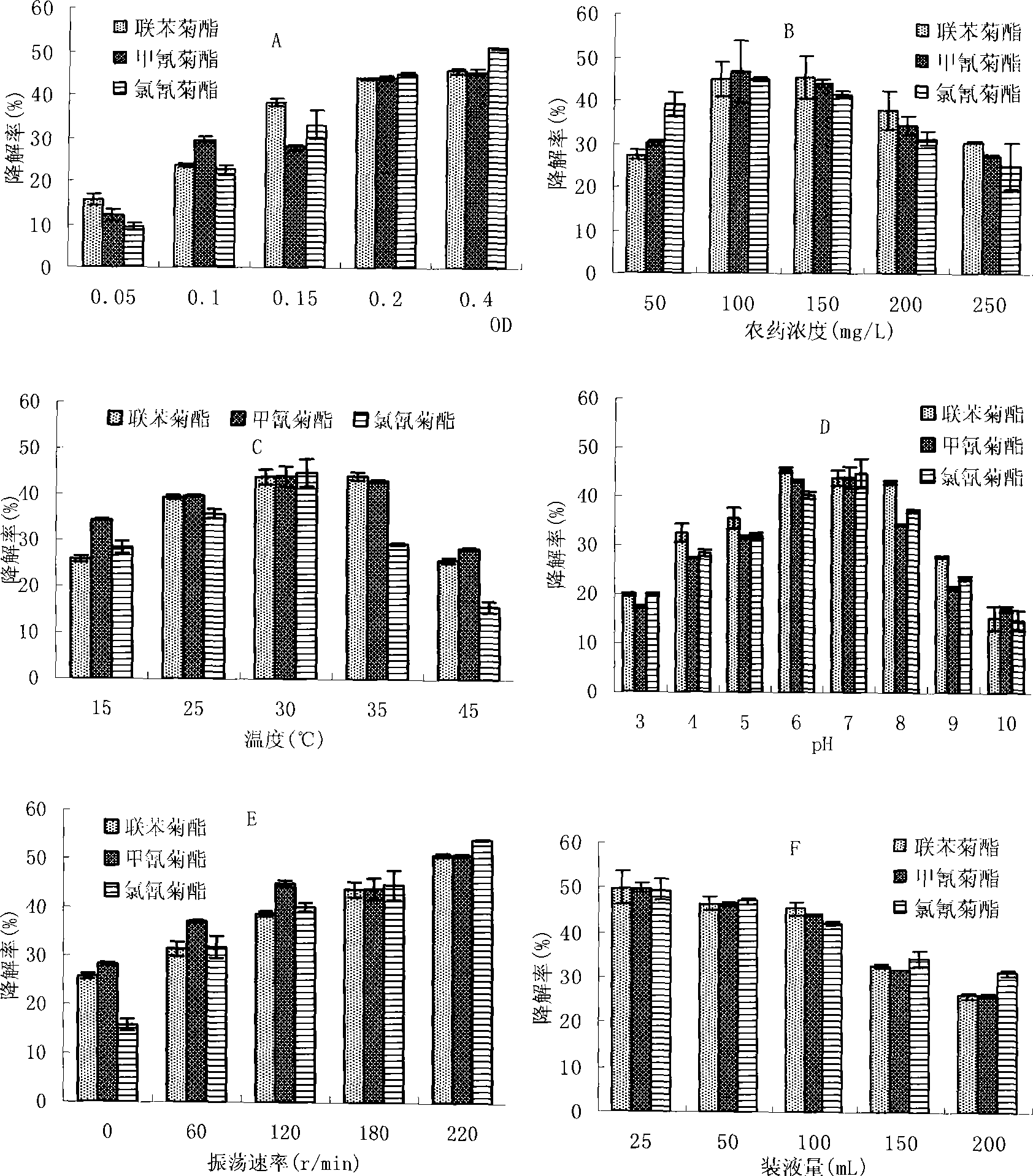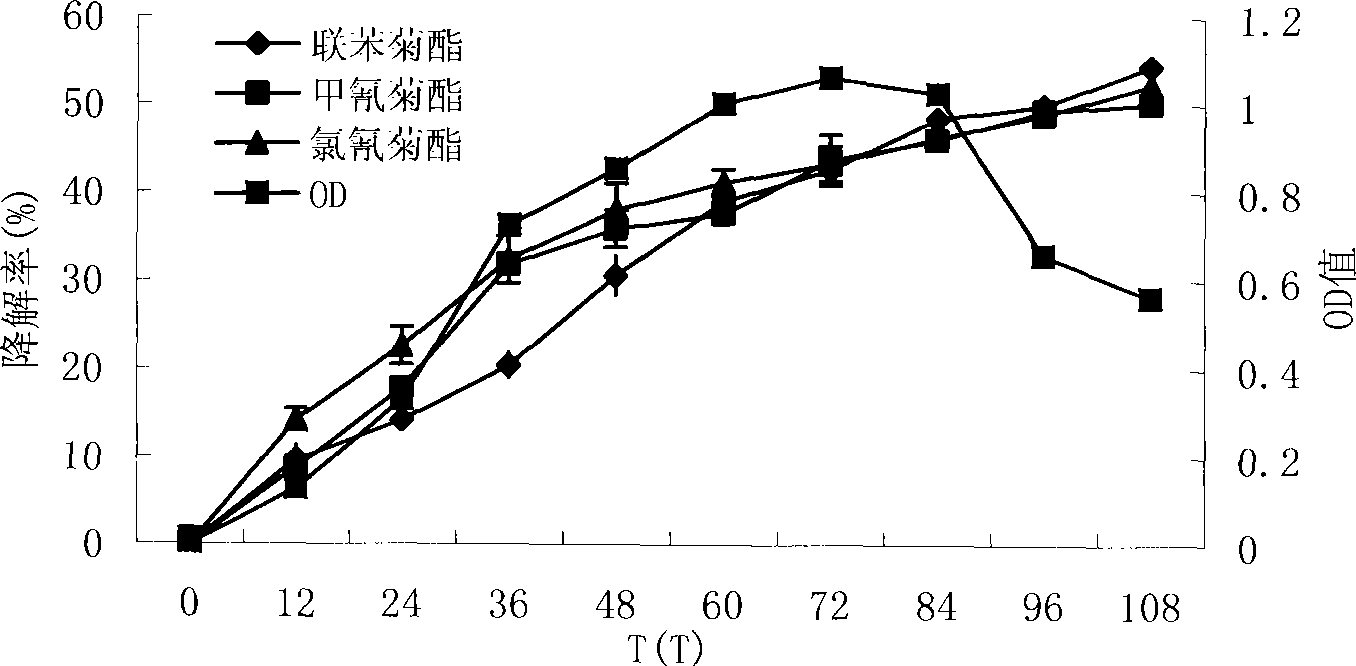Use of pseudomonas diminuta in degradation of pyrethroid pesticide residue and preparation
A pyrethroid, pseudomonas technology, applied in the direction of bacteria, microorganism-based methods, microorganisms, etc., can solve the problem of less microorganisms
- Summary
- Abstract
- Description
- Claims
- Application Information
AI Technical Summary
Problems solved by technology
Method used
Image
Examples
Embodiment 1
[0038] 实施例1:降解菌株的筛选与鉴定
[0039] 1.1培养基和试剂
[0040] 富集培养基:蛋白胨10g,NaCl 1.0g,KH 2 PO 4 1.0g,H 2 O 1000mL,葡萄糖1.0g,pH7.0;
[0041] 基础培养基:NH 4 NO 3 1.00g,MgSO 4 .7H 2 O 0.5g,(NH 4 ) 2 SO 4 0.5g,KH 2 PO 4 0.5g,NaCl 0.5g,K 2 HPO 4 1.5g,H 2 O 1000mL,pH7.0;
[0042] 基础培养基加入1.5%琼脂和100mg·L -1 的联苯菊酯、甲氰菊酯和氯氰菊酯即配成相应的含农药固体培养基;
[0043] 50mg·L -1 的联苯菊酯、甲氰菊酯和氯氰菊酯乳液。
[0044] 1.2菌株对联苯菊酯、甲氰菊酯和氯氰菊酯降解效能的测定
[0045] 将纯化后的单个菌株以菌量OD 415nm =0.2接种到100mL含联苯菊酯、甲氰菊酯、氯氰菊酯各100mg·L -1 的无菌液体基础培养基的250mL三角瓶中,以不接菌的培养液作对照,在30℃,180r·min -1 的恒温摇床上振荡培养3天。培养结束后,吸取2mL培养液,加入4,4,3mL的石油醚萃取3次,加入无水硫酸钠吸水,并定容至10mL,用气相色谱检测。
[0046] 气相色谱检测条件:Agilent 6890GC(G1530N / G3172A)气相色谱仪,HP-5(30mm×0.25mm×0.25μm)色谱柱,ECD检测器,检测温度280℃,柱温260℃,进样口温度280℃,柱流:1.0mL·min -1 ,分流比为1:10,载气为N 2 (99.999%),进样量为1μL。
[0047] 降解率(%)=(对照样品残留量-处理样品残留量)×100 / 对照样品残留量
[0048] 1.3 优势降解菌株选育
[0049] 1.3.1 菌株来源
[0050] 采集杭州农药厂拟除虫菊酯类农药生产车间下水道处驯化过的污泥。
[0051] 1.3.2 降解菌株的分离、纯化和筛选
[0052] 从每份污泥土样中取10g,在无菌的条件下,分别加到含联苯菊酯、甲氰菊酯、氯氰菊酯各...
Embodiment 2
[0070] 实施例2:降解条件的优化
[0071] 1 材料与方法
[0072] 1.1 培养基和试剂
[0073] 富集培养基:蛋白胨10g,NaCl 1.0g,KH 2 PO 4 1.0g,H 2 O 1000mL,葡萄糖1.0g,pH7.0;
[0074] 基础培养基:NH 4 NO 3 1.00g,MgSO 4· 7H 2 O 0.5g,(NH 4 ) 2 SO 4 0.5g,KH 2 PO 4 0.5g,NaCl 0.5g,K 2 HPO 4 1.5g,H 2 O 1000mL,pH7.0;
[0075] 基础培养基加入1.5%琼脂和100mg·L -1 的联苯菊酯、甲氰菊酯和氯氰菊酯即配成相应的含农药固体培养基;
[0076] 50mg·L -1 的联苯菊酯、甲氰菊酯和氯氰菊酯乳液。
[0077] 1.2 菌株对联苯菊酯、甲氰菊酯、氯氰菊酯降解的最佳条件
[0078] 在装有100mL基础培养基的三角瓶中,混合加入联苯菊酯、甲氰菊酯、氯氰菊酯各100mg·L -1 作为碳源,接种量OD 4 15nm=0.2、30℃、pH7.0、振荡速率180r·min -1 、装液量100mL(250mL三角瓶)。最佳条件降解试验通过分别改变基本条件中的接种量(OD 415nm 为0.05,0.1,0.15,0.2,0.4)、农药浓度(50,100,150,200,250mg·L -1 )、温度(15,25,30,35,45℃)、pH值(3.0,4.0,5.0,6.0,7.0,8.0,9.0,0.0)、振荡速率(0,60,120,180,220r·min -1 )或装液量(25,50,100,150,200mL),保持其他条件不变,培养3天,进行单因素条件试验,各单因素设计以不接种为对照,每个处理设3个重复,按照实施例1方法测定菌株同时对3种菊酯农药的降解率。
[0079] 1.2.1 接种量的影响
[0080] The concentrations of bifenthrin, fenpropathrin, and cypermethrin were all 100 mg·L -1 的混合培养基,分别接种初始菌液OD 415nm 值为0....
PUM
 Login to View More
Login to View More Abstract
Description
Claims
Application Information
 Login to View More
Login to View More - R&D
- Intellectual Property
- Life Sciences
- Materials
- Tech Scout
- Unparalleled Data Quality
- Higher Quality Content
- 60% Fewer Hallucinations
Browse by: Latest US Patents, China's latest patents, Technical Efficacy Thesaurus, Application Domain, Technology Topic, Popular Technical Reports.
© 2025 PatSnap. All rights reserved.Legal|Privacy policy|Modern Slavery Act Transparency Statement|Sitemap|About US| Contact US: help@patsnap.com



